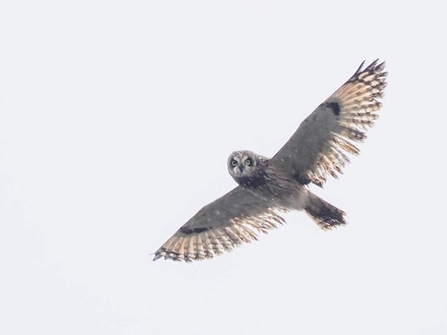
An inquisitive short-eared owl circled Lockwood
Photo credit: @Elliott81758817
Two drake goldeneye arrived mid-month
Photo credit: @MLP

An inquisitive short-eared owl circled Lockwood
Photo credit: @Elliott81758817
There was also an early scaup, another short-eared owl, turnstone and an unusual run of dunlin. But the lack of a genuine rarity, which is often a feature of November, meant it was the first month since December 2021 without a new bird being added to the year list. It means the annual total is stuck on 143, still five ahead of last year but the gap is closing.

The year’s second pintail spent the day on East Warwick
Photo credit: @Callahanbirder
After their post-breeding visit to the coast, the first shelduck normally arrives back in November but this year's first return on the 12th was the earliest in recent years. Two wigeon were seen on the 13th with another pair on the 17th. Having waited two years for a pintail to turn up again at the reservoirs, it was always on the cards that a second would arrive just weeks later with a drake this time on East Warwick on the 16th.

A drake scaup made a brief appearance on No 4
Photo credit: @IvorHewstone
The finding of a drake scaup on the 23rd by DW raised hopes that the regular winterer may have returned particularly as it appeared, as in the past, in the north-west corner of No 4 and, as usual, fell fast asleep. But hopes were dashed when no sign could be found next day. The first goldeneye - an immature drake - arrived on the 3rd but it wasn't until the 18th when more than one bird was seen with two drakes and a female. The three birds - the same number as last November - stayed until the end of the month. Goosander are becoming much more irregular at the Wetlands with no sighting until a drake on the 26th and 28th. The escaped ringed teal, however, clearly enjoyed their one day visit to the reservoirs last month as two males returned on the 14th, 15th and 18th.

Two drake goldeneye arrived mid-month
Photo credit: @MLP
The wide shingle edges on Lockwood helped make it a much better November than normal for waders. It was particularly attractive to dunlin with perhaps as many as five birds this month. Singles were seen on the 16th, a different bird on 17th, on the 19th and two on the 21st. A tame turnstone was also on Lockwood on the 24th with redshank on the 5th & 6th and another on the 27th.
Lapwing were less choosy with both Lockwood and East Warwick providing resting places with four on the 17th, a single on the 21st and seven next day. CF had the third & fourth woodcock of the year - an unusually high number - with the first near the Dragonfly pond on the 17th with another off the side of Lockwood on the 22nd. Snipe in contrast, seemed either less common or more elusive than normal with only a handful of records. Common sandpipers continued to be seen with two until the end of the month.

One of two redshank on Lockwood this month
Photo credit: @HarringayBirder
November was never likely to match October for scarcer gulls but both yellow-legged on the 24th and caspian on the 18th were seen. Common gulls built up with a count of 52 just on the south end of West Warwick, their favourite haunt, on the 26th. Checking colour-rings this month has revealed that among the black-headed gulls wintering are birds from both Slovakia and Poland.
Single red kites were seen on the 5th and 6th with a common buzzard over on the 6th as well. In an Autumn which has seen a major influx of short-eared owls into the country, the reservoirs had its third with one showing particularly well over Lockwood on the 12th.
Skylarks were seen flying over on four days while male blackcaps were seen on the 9th and 20th. Winter thrush numbers were low but there were 15 fieldfare on the 11th with small numbers of this species and redwing feeding around the reservoirs' berry bushes. Up to three stonechats continue to winter while another rock pipit turned up on Lockwood on the 12th. A small flock of up to eight siskins were seen regularly around the site this month with single lesser redpoll on the 6th and 24th.

The third rock pipit of the autumn spent the day on Lockwood
Photo credit: @porthkillier